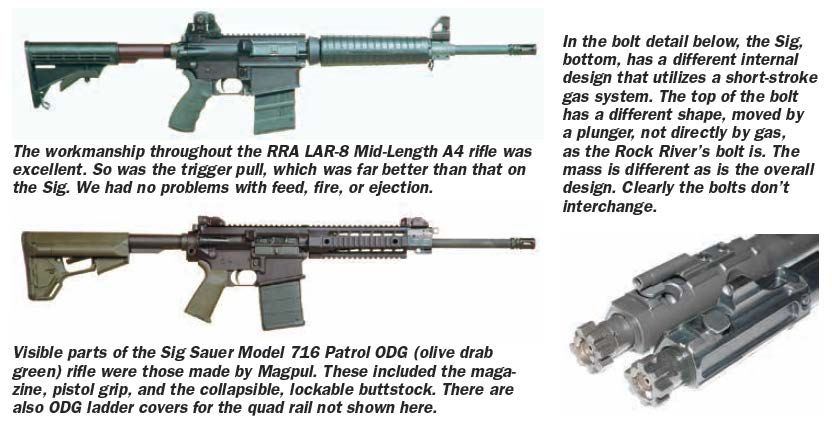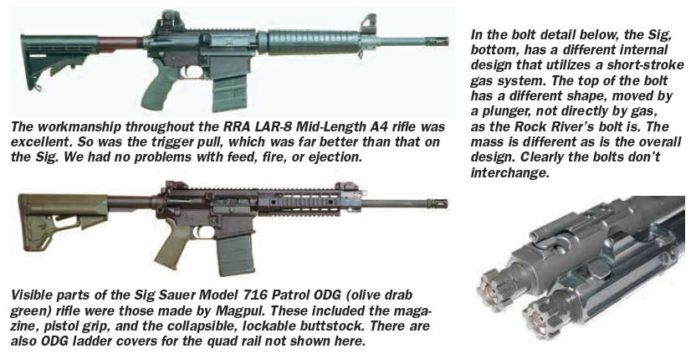Our Idaho test team is not that fond of the AR-15 rifle and its tiny cartridge, but our shooters really do like the 308 Win. versions of the “black rifle.” Thus it was with joy that we unpacked four rifles in that caliber and selected two for this head-to-head test, the Rock River Arms LAR-8 Mid-Length A4 with accessories, which brought its price to about $1335 without sights, and a Sig Sauer Model 716 Patrol ODG, (the latter three letters indicating olive-drab telescoping butt, pistol grip and rail covers), list price of $2186. Here’s what we found.
Rock River Arms LAR-8 Mid-Length A4 308A1239X 7.62NATO, about $1335
We tested with three types of 308 Winchester ammunition: Freedom Munitions with 150-grain FMJ bullets, Federal Match HP with 168-grain Match King BTHP bullets, and with Hornady Match 155-grain JHP (called OTM W/C). We tested in extremely cold weather in Idaho, so we were particularly interested in the rifles’ functioning.

Everything about the rifle worked just fine. We had no problems with feed, fire, or ejection throughout our testing. The rifle gave best accuracy with what we thought was the best ammo, the Federal Match. Even in inclement conditions, many of our three-shot groups were under an inch at 100 yards from our machine rest.
Both rifles excelled with the 168-grain HP Match King round, with the RRA nosing out the Sig 0.9 inches to 1.1 inches in average group size. The Sig Sauer 716 shot slightly better with the Hornady 155-grain JHPs, with 1.5-inch average groups to the RRA’s 1.6-inch average. But the RRA was noticeably better with the Freedom Munitions 150-grain FMJs, 1.6 inches to 4.2 inches.
Also interesting to our team was how consistent velocities were across the board. Average velocity for the Freedom Munitions ammo was 2575 fps for the RRA and only 10 fps faster in the Sig. The Federals shot at 2410 fps and 2415 fps for the RRA and Sig, respectively, and were only separated by 5 fps again (2520 fps and 2525 fps) with the Hornady 155-grain JHPs. Both rifles were so heavy that recoil was never a problem.
The Rock River 308 was a decently done-up rifle with a nice, even, dead-black finish. The package did not include detachable iron sights. The detachable “Stand Alone” rear sight (AR3305A SY, $110) and the front detachable sight (AR0160, $40) are sold separately. They are different heights than standard AR irons, as we proved by installing some excellent folding Magpul sights we had on hand. But as we suspected, they failed to get the rifle to shoot where it looked — they were a foot high at 25 yards, thus 4 feet high at 100, which, of course, is useless. But as delivered, the rifle is optics-ready, so we stuck on a target scope, a 36X Weaver, and wrung this rifle out with that. So rigged, we found out the Rock River was splendidly accurate.
The workmanship throughout the rifle was excellent, we thought. So was the trigger pull, which was far better than that on the Sig.
Our Team Said: We gave the rifle a resounding A, despite having to buy sights separately. In particular, we liked the ambidextrous bolt release. Also, the Rock River comes in a nice hard case, and the Sig comes in a cardboard box.
SIG Sauer Model 716 PatrolODG R716-16B-P-ODG7.62 NATO, $2186
The Sig had four rails arrayed around its forend, which some shooters require, especially those with access to mil-spec extras. We figured you could attach whatever you saw fit, from auxiliary sighting equipment to lights, to laser guidance, or from potato planters to hedge trimmers, you name it. The Sig appeared to us to be about as well made as the Rock River, with nothing to choose between them for workmanship, finish or, as it turned out, function. That was our first impression, which didn’t change a whole lot during our testing.
The Sig had a problem with its flip-up sights. It shot way low, about a foot, at 25 yards. There was no easy way to raise the impact except to lower the front sight, which was already down all the way. The rear was adjustable for windage via two opposing wheels, but the elevation was left entirely to the front sight. The sight would have required lots of motion to set it right. You’ve just spent two grand or so on a new rifle. Is it too much to expect the sights to be at least close to where they need to be? Sig Sauer fell down on this, or so it seems to us.
The Sig has a four-position gas block, which gave the choice of normal operation, or allowed extra gas to go through in case of fouling or other problems. There was a position for the use of suppressors, and you could shut off the gas entirely to permit using the rifle as a single shot. The downloadable manual (from SigSauer.com) explains these in a bit more detail. We suspect shooters will find these options handy on occasion, especially the single-shot option for training. We also liked the short-stroke idea, which promises to keep the action cleaner.
For us, some of the more endearing visible parts of the rifle were those made by Magpul. These included the magazine, pistol grip, and the collapsible — but lockable — buttstock. We had tested an accessory stock by Magpul some time back that essentially did what this one does, which is to allow the buttstock to be locked firmly in place with no rattling, once the length is selected. This one does that a lot easier, yet releases even faster. This buttstock also had three compartments for storing things, two of them hidden.
The pistol grip, also by Magpul, had yet another compartment. That is to us very good use of space otherwise lost on such a rifle. The fact that Sig Sauer puts these parts on as original equipment speaks volumes for the quality of the Magpul products. We might add that inside one of the compartments are two black-plastic dummy 223 rounds. Don’t throw them away. They are needed to remove the stock from the rifle. Magpul’s magazine designation is PMAG, the stock designation is 1LX50, and the pistol grip with trap is M8E.
The trigger guard had a clever feature. Depress a plunger on its right side and you can swing the bottom plate of the guard down out of the way to get a gloved hand onto the trigger. This would require extreme caution in use, but at least you have the option. The Rock River had the same option, but it had only one storage compartment in the base of its rubber grip, and not a very secure one either, consisting of a rubber plug retained by friction. So we liked the compartments and locking butt of the Sig, but would it shoot?
Once again we pulled the sights off the rifle to make room for our long 36X Weaver, and repaired to the range. We found the trigger pull to be not as good as that of the Rock River, in our estimation. We would consider installing one of the aftermarket triggers tested previously on these pages, either a Geissele or a Timney, before we’d be entirely happy with the pull. That would add a bunch to the already costly rifle. The accuracy was not quite as razor-sharp as that of the RRA, though plenty good enough. Functioning was perfect.
Our Team Said: We gave the Sig an A-minus, mostly for the not-great trigger pull. The rifle did what it was supposed to, though the folding iron sights were a disappointment. You get a lot of neat things with the Sig Sauer that are missing from the RRA, but you pay for them. The Sig website has an interesting video that illustrates many of the internal custom touches on the Sig rifles. Are they worth the $865-odd more the Sig costs over the RRA? That’s your call. Frankly, we could well do without the four rails up front, but that is not an option from Sig Sauer. Please note that unlike within the many 223-caliber AR-platform rifles, the many parts of the 308-caliber AR-type rifle families are generally not interchangeable. Attempting to make parts fit where they don’t belong may cause the experimenter to risk grave injury or worse.
Written and photographed by Ray Ordorica, using evaluations from Gun Tests team testers. GT
































